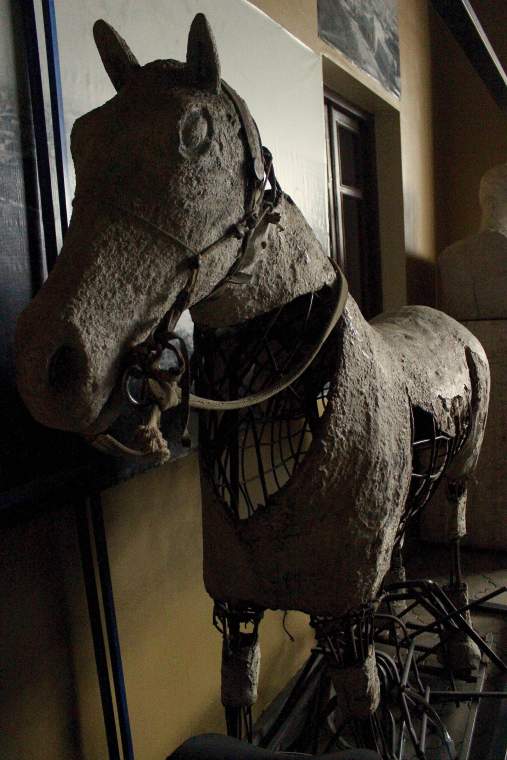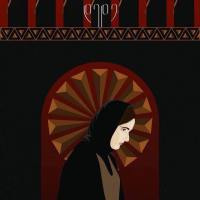A Theatrical Day on Rustaveli Avenue

An old prop from the Rustaveli Theatre
I stopped in to visit my friends at the hand shadow puppet troupe Budrugana Gagra, of whom I have written about in the past and will do so again before I leave Tbilisi. It was a day when various things had conspired to make life somewhat quiet for them. But I had been told by Elene Murjikneli that I could have a tour of the building that they were in and that was the prestigious Rustaveli National Theatre. So she took me over to the elevator from the basement in a newer connecting building and we began our tour. I had already had a glimpse of the theatre when I went to watch Budrugana Gagra perform in what was called the ‘small room’. The ‘small room’ was an ornate space holding over 280 people and was larger than the Chilkat Center for the Arts back in my hometown of Haines, Alaska. But compared to the main auditorium of the Rustaveli Theatre which held 800, it was, I suppose, small.
The Rustaveli Theatre was original built in 1887. With a couple of additions since then. Besides the main hall and the small stage there was also a black box stage as well as an experimental theatre. And the place is labyrinthine and elaborately decorated. Elene first took us up five flights and then we took another elevator to a floor below the roof. We walked through a window and suddenly were standing in a gutter outside overlooking the city. Not the place for folks with vertigo. It was lightly sprinkling and the metal at out feet was wet, yet it was an unforgettable view. Tbilisi spread out beyond us, including modern buildings, older rustic structures, Soviet era apartment blocks, and the current president’s house about a block away. She almost took me all the way to the highest part of the roof but the slipperiness of the sheet metal made that a dodgy proposition. We did climb into another strange rooftop room with a curious round hole in it before descending into more chambers.
We stepped onto the stage of the theatre which was set up for performances, and then I had a chance to see the main hall. Wandering around any theatre is always a treat, because the mind begins to wander dreaming up possibilities for events to be staged. We walked through another oversized hall that was grace with theatrical props and memorabilia. Before long we came to the front of the building, where the Rustaveli Avenue traffic could be seen through thick doors of wood and glass. We then descended…
Underneath the front entrance there had once been a cafe sponsored by the Artists’ Society that had founded the theatre. It had been a serious artistic and literary hangout in the early 20th Century up until the period of Georgian Independence ended in 1921 (See Georgian Lessons #7). Artist like Lado Gudiashvili and Davit Kakabadze had painted the walls. The Soviets in their passion to cleanse any trace of the bourgeoisie had painted over their frescoes. Yet traces of that older heritage could be discovered. Elene took be through a dark passage. She told me to look at the walls. Suddenly I saw the walls were covered by a painting from door to door from ceiling to floor. I took a few flash photos to capture the experience.
We then walked into a darkened area that was filled with passages and and heavy stone pillars. And Elene said that there were even more chambers below that were locked away from us. She said there was one theatre worker who knew all of the hidden secrets of the Rustaveli. And I was thoroughly captivated by the subterranean dark. But eventually it was time to thank Elene and to move on back out to Rustaveli Avenue.
As I was walking down the street I stopped at a sign in Georgian script. My comprehension of the Georgian alphabet now is now nearly complete. I read the word slowly to myself… ე რ ი ს ი ო ნ ი. Erisioni! I had found the home of the musical singing and dance troupe Erisioni. I had originally seen their DVD, Georgian Legend, which contained beautiful songs and astounding dances. I had been looking for them. And I knew they were somewhere in the area. I had walked by this old building dozens of times. There was no Latin script. But I had indeed found them. I walked inside of the dimly lit austere building. If the guys at the door were guards of some sort they didn’t seem to notice me. But then again I learned a while ago here always walk passed the various guards like you know what you are doing. Evidently school classes were on for singing and dancing. Students were coming in. I walked up the old cracking stairs in the darkened chamber and feeling a bit lost I eventually stopped a girl who looked friendly too ask her she spoke English. Not well, but well enough to tell me where the office was and that they weren’t there now. And so I would come back. (And I did but that’s an entirely different story but here’s a little preview.)
Click this and WATCH IT!
After a pleasant chat with Tamar over at Prospero’s Books, the English language bookstore, I eventually made my way over to see the Romeo and Juliet ballet by Prokofiev over at the Paliashvili Opera and Ballet State Theatre. This was now the third ballet I’d seen here after the Nutcracker in January and the Firebird in 2016. Ii was feeling like my ballet home, since the prices were both very affordable for me and of high quality. I was quite familiar with Sergei Prokofiev’s music and had long counted it as a favorite classical work. I had a perfect seat for viewing the show until a couple of women plowed through a row of folks in front of me at about the third dance. One woman of not inconsiderable size plumped down directly in front of me sitting high in her seat and sporting frizzy hair in what was practically an afro. And so I had to squirm around to see past her to the dancing, rather than sitting high in my own seat and blocking the view of the folks behind me. (But since this is Georgia, they would have suffered in silence.) Fortunately the chairs next to me never were filled and after the intermission I changed seats. And just in time for the dancing of the second half was quite stirring with the death of Tybalt and the weeping over his body hitting unexpected notes of emotion within. The finale of the ballet was also quite moving. And as the actors took their bows I noticed that Artistic Director and Prima Ballerina Nina Ananiashvili come out to present some of the bouquets.
I had quite an excellent conversation with Nina Ananiashvili back in 2016 and so I found her after the show and we made arrangements to meet again in the near future. And I left that evening walking up Rustaveli having had an excellent day of exploration, conversations, connections and ballet. I felt like I had finally reconnected with the Tbilisi I had left in 2016 and even surpassed that moment.

Taking a Bow

Juliet, Nutsa Chekurashvili





























Pingback: Bravery and Grace: Erisioni #1 | GRAVITY FROM ABOVE